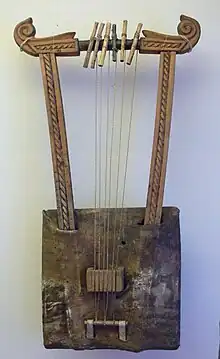 A wooden krar. | |
| String instrument | |
|---|---|
| Classification | lyre |
| Developed | Ethiopia and Eritrea |
| Related instruments | |
| masenqo | |
Krar (Geʽez: ክራር) is a five-or-six stringed bowl-shaped lyre from Ethiopia and Eritrea. It is tuned to a pentatonic scale. A modern Krar may be amplified, much in the same way as an electric guitar or violin. The Krar, along with Masenqo and the Washint, is one of the most widespread musical instruments in Northern Ethiopia and Eritrea.[1]
Role in society

Historical
In Amhara society the krar was viewed as an instrument inspired by the Devil and was therefore inferior, whereas the Begena was for praising God and seen as sacred. The krar was used to adulate feminine beauty, create sexual arousal, and eulogize carnal love.[2]
The instrument has been associated with brigands, outlaws, and Wata or Azmari wanderers. Wanderers played the krar to solicit food, and outlaws played it to sing an Amhara war song called Fano.[2]
Contemporary
Today, the krar which used to be the plaything of the Ethiopian and Eritrean, has become one of the most popular Ethiopian stringed instruments.[2]
The krar is and was always used to accompany and perform secular song, love songs, and (vulgar) poetry. The instrument is often played by Poet-musicians called the Azmari or Wata [3]
Features

A chordophone, the krar is usually decorated with wood, cloth and beads. Its five or six strings determine the available pitches. The instrument's tone depends on the musician's playing technique: bowing, strumming, or plucking. If plucked, the instrument will produce a soft tone. Strumming, on the other hand, will yield a harmonious pulsation.
Resources
- Asnakech Worku, Ethiopiques 16: The Lady with the Krar (compact disc). Buda Musique 822652, 2003.
- Ethiopie, chants d'amour (Ethiopia, Love Songs). Fantahun Shewankochew, vocals and krar (compact disc). INEDIT/Maison des Cultures du Monde W260080, 1998.
Films
- HELP! – Musikalische Geschichten aus Äthiopien. Directed by Daniel Schulz.[4]
See also
References
- ↑ Mekonnen, Timkehet Teffera. "Timkehet Teffera (2020). Shungul, Sorror, Washint, Woissa, Zumbara".
- 1 2 3 Milkias, Paulos (2011). Ethiopia. Santa Barbara, California: ABC-CLIO. p. 344. OCLC 728097838.
- ↑ Kebede (1977). "The Bowl-Lyre of Northeast Africa. Krar: The Devil's Instrument". Ethnomusicology. 21 (3): 381. doi:10.2307/850725. JSTOR 850725.
- ↑ "Kino Kombat | Filmmanufactur". Kino-kombat.com. Retrieved 20 April 2021.